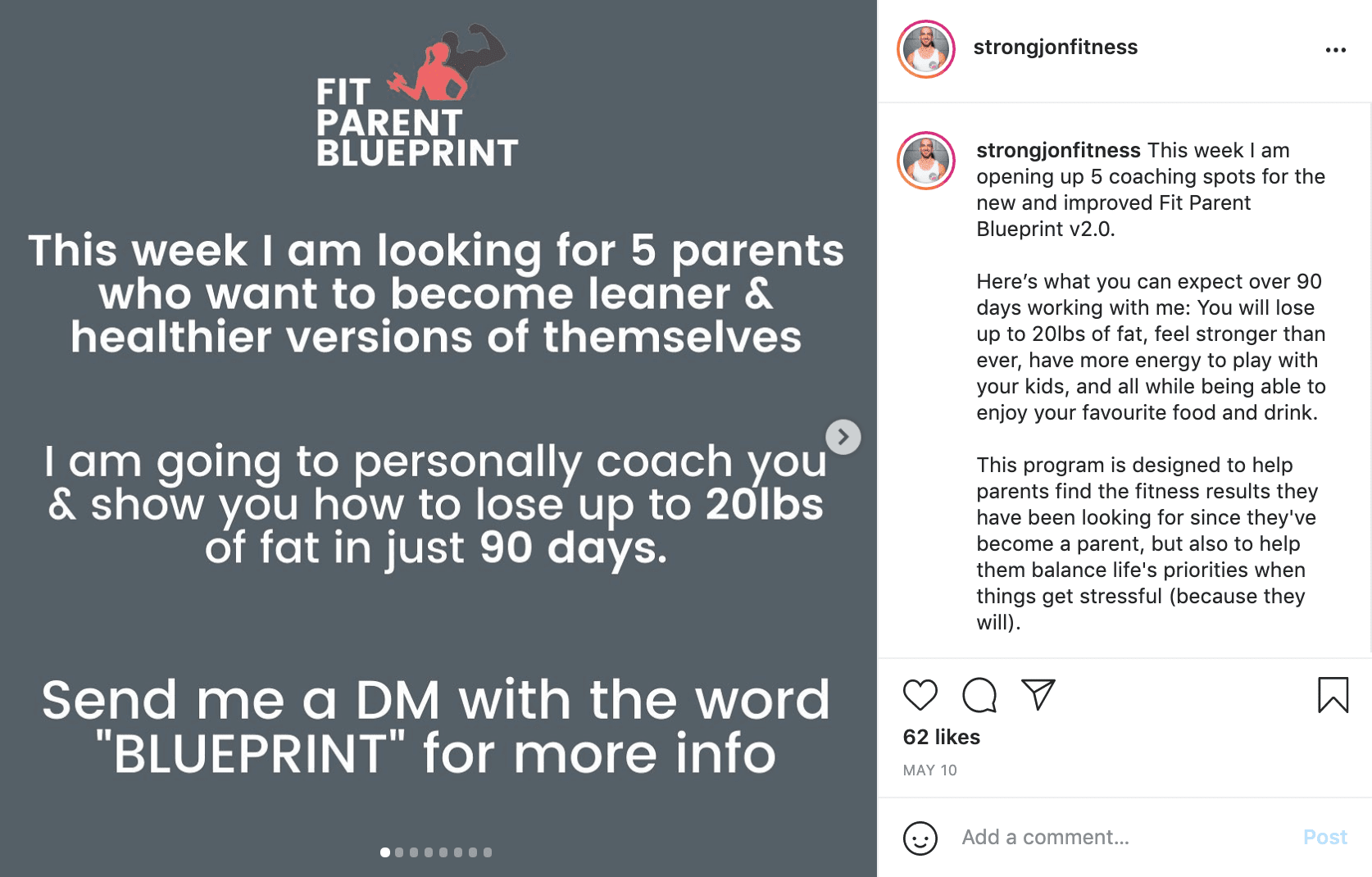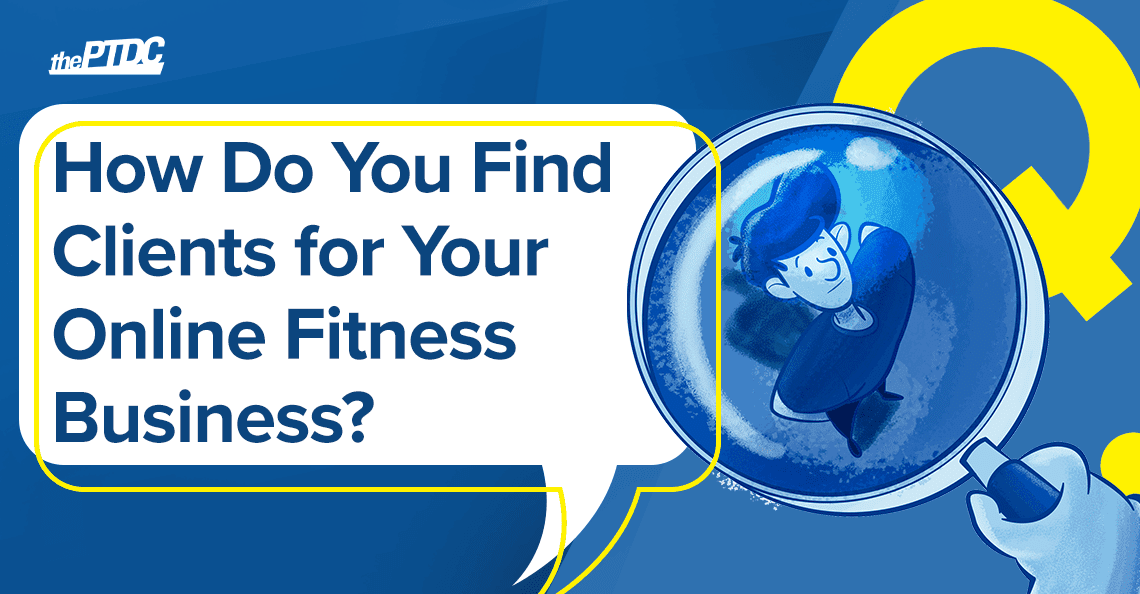 Finding clients is the essence of our business.
Finding clients is the essence of our business.
All the programming you’ve learned, tips about Instagram, strategies about market positioning—they don’t mean much if you can’t find customers.
So let’s dive right in. I’ll keep it basic here because the details can be found elsewhere, including in our Online Trainer Academy materials.
But for now, here are three main approaches for finding clients. The one you choose will depend on the time you have, your budget, and your goals. The big three:
- Pay to play (paid ads)
- Short-term, short-lived
- Long-term
How do you find clients for your online fitness business? (Three ways)
1. Pay to play (paid ads)
I put “pay to play” first because that’s the one you hear about most. It involves an outlay of money—sometimes significant—and a serious commitment of time and effort in creating content and setting up a conversion system.
This can definitely be the way to go when you’re ready to seriously scale up.
Who uses it? You’re probably not there, if you’re asking me how to find clients. So it’s not where you should start.
I have nothing against these techniques because my business uses a lot of them! But I’ve been at this for a long time.
Keep this overview in mind as you build your business.
In the “pay to play” scenario, you’re constructing an infrastructure of sorts. It includes:
- Paid advertising to get your services known on social media.
- Marketing funnels to narrow your audience down to those who are ready to buy.
- Conversion systems to complete the sales, through your web page or phone calls.
There’s a lot to this, right? It requires sharp sales copy, a rock-solid tech foundation, and a sales process that can handle volume.
And through all of this, you’re competing against everybody else’s advertisements. You’re competing for billboard space on a crowded roadside.
That can be fine when you’re established. But we don’t recommend it unless you’re already doing $10,000 a month with your online fitness business and are looking to scale up.
But sure, paid ads can work really well and generate great returns. Especially if you’ve clearly identified your client avatar—you know their language, you know how to reach them.
You can invite them into a Facebook group, for instance, a free group that you nurture.
Then you can reach out to potential clients for personal conversations via DM. It’s called a “SPEAR post” (Short. Personal. Expecting A Reply) and all of this works great.

But pay to play is not how you start. There’s a lot to it and a lot of money involved.
Which brings us to the second way to find clients …
2. Short-term, short-lived
This may be your sweet spot. It’s a great way to land your first five or 10 clients, and it’s what I recommend for trainers just starting out in the online space.
The basic steps in the short-term, short-lived approach:
- Identify your target.
- Create content aimed at them.
- Issue a call to action.
For that third step, I’ll tell you about a very specific approach—a personal approach as opposed to a general appeal—that I came up with years ago.
It’s called the Founding Client Challenge, and it’s generated more than 5,000 new clients and millions in revenue. (We stopped tracking it last year but it continues to generate crazy numbers to this day.)
More on that challenge in a minute.
First comes identifying your target population. This helps in so many ways, from focusing on your ideal client, to precisely pitching them, to converting them into paying clients.
It simplifies things and it pays off.
Identifying your target is up to you. All I can tell you is that you need to know them. You need to know their language. You don’t necessarily have to be like them, but you need to understand them.
Narrow your target by age, sex, occupation, marital status, goals (like weight loss or strength or flexibility), whatever you want.
This narrowing will help you figure out a way to speak to one person. Or else you’ll speak to nobody.
This is crucial to finding clients. It’s easier and more effective than, say, broadcasting to a huge demographic. This doesn’t mean turning someone away who does fit your target profile, of course. But it’ll help you hone your pitch to a specific individual.
Identifying your target can guide your next task, which is to create content.
You should create a week’s worth of content. You’re going to post two or three times a day, and one of those posts will be live for a week.
This is what you pour your knowledge into. Make videos, write programs, outline nutritional plans, come up with inspirational copy.
Aim everything at that ideal client. Speak their language, find their groups.
Get all that content teed up and roll it out for a week.
At the end of the week is your call to action. You want your target to sign up.
This is my favorite kind of call to action. And my favorite challenge is called the “5–1–60” statement.
That means you’re looking for FIVE clients who have ONE goal that they’ll get in 60 days.
There's nothing magical about those numbers. Pick your own. But this one works.
So you post this challenge:
I’m looking for five men, aged 30 to 45, who want 5 pounds more muscle so they’ll look great in a T-shirt by summer, in 60 days.
So that’s five clients, one goal, 60 days.
Now here’s the kicker.
These five people will get a deal. They are my test drivers. I tell them this program is going to cost $500 when I release it officially.
But as my testers, it’ll only cost them $197. In exchange, they’ll have to give me feedback, let me use them as case studies, maybe provide a testimonial.
This works. Come up with your tweaks, your own price points.
But it’s a great way to get started. And what we’ve found is that online training is like a big stone wheel.
You need a lot of push and momentum to get started. But then it just kind of spins on its own.
And eventually you can start thinking “long-term.”
3. Long-term
Long-term is what it sounds like, and everyone should be practicing its principles, basically all the time, at whatever stage of their career they’re in.
You’re talking about committing yourself to the long haul, which means you’ll:
- Establish your reputation.
- Create your own high-value content.
- Cement strong client relationships.
This is the stuff that you should be doing every single day, to be honest.
Once you get it going, your business runs on autopilot. But it takes time to get going.
And this is where I recommend another simple task:
Have FIVE conversations with FIVE people EVERY DAY.
I love this because it cuts through the crap about funnels and Instagram posts and marketing language.
It gets right down to the essence: talking with people.
It doesn't matter who they are. You have to talk to human beings if you want human beings to buy from you.
What should you talk about? Whatever!
Have a conversation. Take an interest in what someone is doing.
Doesn’t have to be about fitness. You see a guy play a guitar riff on Facebook—tell him that was cool, ask him how he got into guitar.
Now that you’ve started a conversation, you can show up in their feed, say. And if he sees your feed—and it’s clear you’re a trainer—well, you’re making progress.
Do that five times a day, every day, and you will get lucky.
Success is about catching a lucky break. It’s about the strength of weak ties. It’s about enough people knowing that you’re an expert.
It’s about somebody who knows somebody who knows somebody who’s looking for a trainer. And boom—you’ll get that recommendation.
Your content will help establish what makes you unique. Your service and support will establish your reputation.
And that’s where long-term success lies.
How you find clients depends on your budget and goals and time, of course. You’ll use parts of all three approaches I’ve outlined.
But it all starts with talking to people.
Learn more: Get answers to more online trainer questions.










